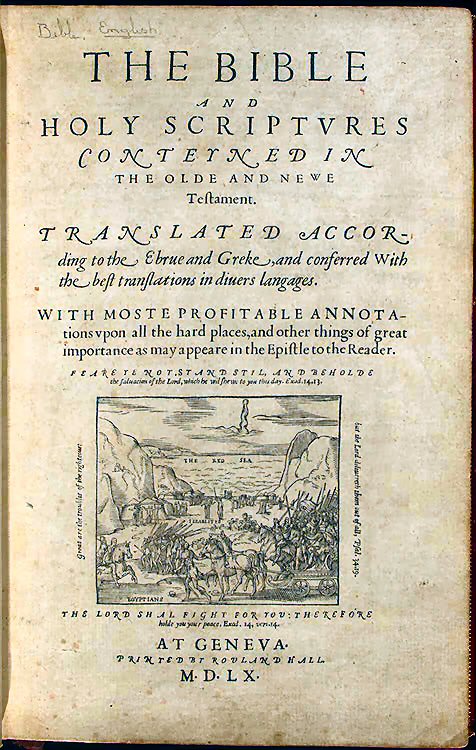Source:https://biblereasons.com/kjv-vs-geneva-bible/
Do you know when the Bible was first translated into the English language? Partial translations of the Bible into Old English go back as far as the 7th century. The first complete translation of the Bible (into Middle English) was by the early English reformer John Wyclyffe in 1382.
William Tyndale started translating the Tyndale Bible into Early Modern English, but the Roman Catholic Church had him burned at the stake before he could finish. He had completed the New Testament and part of the Old Testament; his translation was completed by Miles Coverdale in 1535. This was the first translation into English from Greek and Hebrew manuscripts (along with the Latin Vulgate). Miles Coverdale used Tyndale’s work and his own translations to produce the Great Bible in 1539, the first authorized version by the new Church of England after the English Reformation.
The Geneva Bible was published in 1560, the Bishops Bible in 1568, and finally the Authorized King James Version in 1611. In this article, we will compare the Geneva Bible and the King James Version, both of which had a significant impact on the newly formed Protestant churches and the faith of believers who finally had their own Bible in their own language.
Origin
Geneva Bible
This Bible was translated and first published in Switzerland in 1560. Why Switzerland? Because Queen Mary I in England was persecuting Protestant leaders, causing many of them to flee to Geneva, Switzerland, where they were under the leadership of John Calvin. Some of these scholars translated the Geneva Bible, led by William Whittingham.
The reformers felt it was important that everybody have a Bible in their own language. In the past, people were accustomed to hearing the Bible read in church, but the Geneva Bible was meant for families and individuals to read at home, as well as to be read in church. The Geneva Bible was used in Geneva as well as England. It was carried to America by the Puritans on the Mayflower.
The Geneva Bible was the first mass-produced Bible printed on a mechanical printing press and made directly available to everyone (up until this time, usually only priests and scholars and some nobility had copies of the Bible). It was like our study Bibles of today, with study guides, cross-referencing, introductions to each Bible book, maps, tables, illustrations, and notes. Lots of notes! The margins of most pages contained notes on the material, written from the Calvinist perspective of the translators (and many written by John Calvin himself).
The 1560 edition of the Geneva Bible contained the Apocrypha books (a group of books written between 200 BC and AD 400, which are not considered inspired by most Protestant denominations). Most later editions did not. In editions that did contain the Apocrypha, the preface stated that these books did not have the authority and inspiration of the other books of the Bible but could be read for edification. Very few of the margin notes appeared in the Apocrypha books.
KJV Bible
When King James I came to the throne, the Protestants had gained control of England and the Church of England needed a Bible for the churches and for the people. The Bishops Bible was being used in the churches, but many people had a Geneva Bible at home.
King James disliked the Geneva Bible, because he felt that the annotations in the margins were too Calvinist, and, more importantly, they questioned the authority of the bishops and of the king! The Bishops Bible was too grandiose in language and the translation work inferior.
The common people liked the notes and other study helps in the Geneva Bible because it helped them understand what they were reading. But King James wanted a Bible that did not have the Calvinist-slanted notes but rather reflected the episcopal church government. It needed to be simple enough for the common people to read (as was the Geneva Bible but not the Bishops Bible). He charged the translators to use the Bishops Bible as a guide.
The KJV was a revision of the Bishops Bible, but the 50 scholars who completed the translation consulted the Geneva Bible heavily and often followed the Geneva Bible’s translation. They even snuck in some of the notes from the Geneva Bible in some early editions!
The Authorized King James Version was completed and published in 1611 and contained the 39 books of the Old Testament, the 27 books of the New Testament, and 14 books of the Apocrypha.
At first, the King James Version was not selling well, as people were loyal to the Geneva Bible. Consequently, King James banned the printing of the Geneva Bible in England and later the archbishop banned the Geneva Bible being imported to England. Printing of the Geneva Bible continued surreptitiously in England.









I find it amusing that “King James Onlyists” are mostly fundamentalist baptists, who adhere to calvinist doctrines, I imagine the puritans and original baptists would be rolling in their grave finding out that a church that prides itself on independence and decentralization uses a bible meant to promote hierarchy and unity (KJV) instead of the Geneva bible.
It seems Americans don’t really know their own Christian history.